| Start of section
Production, amateur Radio amateurs Aircraft model, rocket-model Useful, entertaining |
Stealth Master
Electronics Physics Technologies Inventions |
Secrets of the cosmos
Secrets of the Earth Secrets of the Ocean Tricks Map of section |
|
| Use of the site materials is allowed subject to the link (for websites - hyperlinks) | |||
Navigation: => |
Home / Patent catalog / Catalog section / Back / |
|
INVENTION
Patent of the Russian Federation RU2253747
![]()
POWER SUPPLY (WIND)
The name of the inventor: Veynberg Veniamin Yakovlevich (RU)
The name of the patentee: Weinberg Veniamin Yakovlevich (RU)
Address for correspondence: 125319, Moscow, ul. Usievicha, 1/5, apt.73, V.Ya.Veynberg
Date of commencement of the patent: 2000.12.06
The invention relates to wind energy, namely to devices that convert the energy of air movement into electrical energy. The technical result consists in increasing the efficiency of the device by simplifying its design and reducing the number of transmissions. The power converter contains a vane wind turbine made in the form of blades mounted on the working shaft, a drive shaft kinematically connected to the working shaft of the electric generator, and a guiding shank. The operating shaft and the drive shaft are rotatably mounted on one bracket and are connected to each other via a conical transmission, the bracket being independently rotatable about the axis of the drive shaft, and the guide leg of the weathervane is connected to the same bracket.
DESCRIPTION OF THE INVENTION
The claimed device relates to power plants using as a source of energy the force of movement of a gas, for example air, and converting it into electrical energy, as the driving element of which the blades are used. This device can find wide application in industry and household for the production of electrical energy.
An energy converter is known, comprising a wind turbine connected to an electric power generator and a guiding tail. (Patent RU 2064603, cl. 6 F 03 D 5/00, dated 27.07.96).
The disadvantage of this device is the need to suspend the generator along with the wind turbine, which greatly complicates the electrical communication system and operation of the device.
A device is known comprising a blade rotor kinematically connected to a shaft of an electric power generator, and a guiding wing or a guiding tail, or a guiding shank. (Patent RU 2079703 dated May 20, 1997).
The disadvantage of the known device is the complexity of the design with a large number of mechanical transmissions that reduce its efficiency.
The object of the invention is to improve the efficiency of the device by simplifying its design and reducing the number of transmissions.
This goal is achieved due to the fact that the wind turbine is made in the form of a weather vane, the working shaft of the lobe device is mounted on the bracket with the possibility of rotation about its axis, on the opposite side on the same bracket there is a shank or control wing or control tail, the working shaft Through a conical transmission is connected to a drive shaft rotatably mounted to a horizontal portion of that bracket which is rotatable with respect to the drive shaft connected to the shaft of the electric power generator.
The power converter is explained by the following drawings:
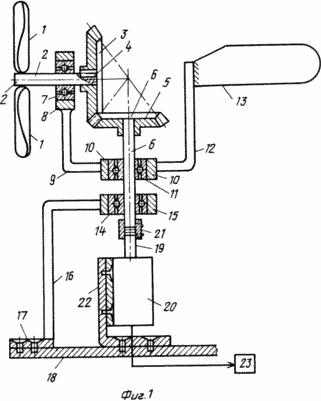 |
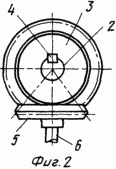
|
|
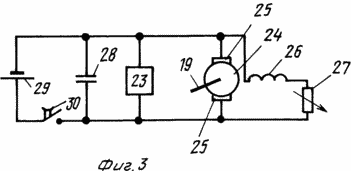 | ||
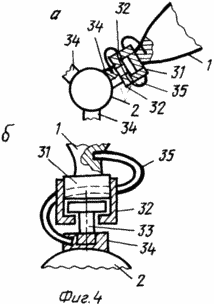 |
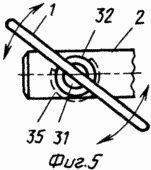 |
1 - Schematic diagram of the device. FIG. 2 shows the device for conical transmission of the device. FIG. 3 - Schematic circuit diagram of the device. 4 a) and b) - Blade joint assembly with a working shaft. Fig. 5 - Blade connection unit with a working shaft. |
The power converter comprises blades 1 fixed to a horizontal working shaft 2, for example welded to it, on the opposite side on which is mounted a bevel gear wheel 3 which is fixed with a key 4. The wheel 3 is connected to the pinion 5, fixed, for example, pressed, on a vertical drive Shaft 6. A horizontal bearing shaft 2 is provided between the blades 1 and the wheel 3 by a bearing 7, for example, an inner ring thereof is pressed on it, on the outer ring of which there is a bushing 8, for example pressed on it. A corner bracket 9 is connected to the sleeve 8, for example welded to it, the other end of the bracket 9 is connected to the sleeve 10, for example welded to it, in which the bearing 11 is mounted, for example, in its outer ring is pressed, and its inner ring is pressed on a vertical drive shaft 6.
On the opposite side, with respect to the connection point of the bracket 9 to the sleeve 10, another corner bracket 12 is connected to this sleeve 10, for example welded to it. At least one guide shank 13 is connected to the vertical part of the bracket 12, for example welded to it, the guide vane 13 of the weather vane can otherwise be called a guiding tail or a guide wing.
A bearing 14 is mounted on the drive shaft 6, for example, its inner ring is pressed onto the drive shaft 6, and a sleeve 15 is pressed on its outer ring, to which is connected a stand 16, the base 17 of which is fixed to the frame 18, for example, on a roof or other part of the structure.
The shaft 19 of the electric generator 20 is connected to the drive shaft 6, for example, by means of a coupling 21. The electric generator 20 can be mounted on a stand 22 which can be attached to the frame 18. The electrical output of the generator 20 is functionally connected to a load 23 which can be light bulbs , Heaters, radio and TV receivers, etc.
In an energy converter, electric power generators with different schematic electrical circuits can be used. FIG. 3 shows an exemplary embodiment of a circuit diagram of an electric generator 20 with parallel excitation. In this example, the armature windings 24 through the collector brushes 25 are electrically connected to the excitation winding 26 and the variable resistance of the control rheostat 27 in the excitation circuit in series with it. At the output of the generator 20, a casing 23, for example a light bulb, a heater or other electrical appliances, may be installed, in parallel to which a battery 28 and a current source 29 can be installed, in turn, a start button 30 can be installed in series with the latter.
The blades 1 mounted on the working shaft 2 can have various shapes: for example, they can be made in a helical shape or in the form of an impeller.
The blades 1 can be mounted on the operating shaft 2 rotatably with respect to a longitudinal axis that is perpendicular to the axis of the operating shaft 2, this can be done by the following connection: from the end of the blade of the blade 1 is a cylindrical heel 31, for example welded to it, The flare nut 32, for example, by means of a threaded connection, in the cavity formed by the lower part of the heel 31 and the union nut 32, is mounted a mushroom bearing 33 with the possibility of rotating the heel 31 with the union nut 32 around its axis. The thrust bearing 33 is mounted, for example, by a threaded connection on a bend 34 which is connected to the working shaft 2 perpendicular to its axis, for example welded to it or has a threaded connection therewith. The blade of the blade 1 is fixed to the bend 34 by a return spring 35, one end of which is inserted into the hole formed in the lobe of the blade 1 and the other end is inserted into the bore provided in the bend 34, its axis coinciding with the axis of rotation of the heel 31. The blade of the blade 1 is part of it, and the bend 34 is part of the operating shaft 2, thus, it can be assumed that the spring 35 connects the blades 1 and the working shaft 2.
Thus, the blades are mounted on the shaft with oscillating motion about the axis of the thrust bearing 31, more precisely with respect to the axis perpendicular to the axis of the operating shaft 2, deviating from the position determined by the spring 35 in a strong gust of wind.
So all the blades 1 installed on the shaft 2 can be made, for example there can be three of them and they are installed at an angle of 120º, relative to each other.
The sleeve 8, the bracket 9, the sleeve 10, the bracket 12, rigidly connected to each other, represent the sections of the single bracket on which the operating shaft 2, the drive shaft 6 and the guide shank 13 are installed.
The entire structure located above the shaft 21 of the generator 20, starting from the drive shaft and ending with the blades 1, can be called a wind turbine made in the form of a weather vane.
The tripod 16 serves as an additional lock through the sleeve 10 with the bearing 11 of the drive shaft 6.
The power converter operates in the following manner: the wind starts to rotate the blades 1, this rotation through the working shaft 2 is transferred to the bevel gear wheel 3, which starts to rotate the gear 5. The gear 5 rotates the drive shaft 6, which in turn drives the shaft 19 and the generator 20 starts Generate electric energy, transmitting it to the load 23, the lights turn on, the heaters heat up, etc.
As soon as the direction of the wind changes, the guide shank 13, which can be several and they can be mounted on the bracket 12 in parallel, unfolds the blades in the direction of the wind, excluding their idle time and increasing the efficiency of the energy converter.
Thus, the brackets 9 and 12 connected to each other through the sleeve 10 are, as it were, a single unit and can be arranged in the same plane or parallel planes and mounted on the drive shaft 6 through the bearing 11 with the possibility of independent rotation from the rotation of the drive shaft 6 With the vertical axis of rotation, and the working shaft 2 with blades 1 is mounted on the bracket 9 through the sleeve 8 and the bearing 7 is rotatable about the horizontal axis, this rotation through the conical transmission is transmitted to the shaft 19.
Blades 1 are usually deployed at a certain angle with respect to the plane of the cross-section of the working shaft 2, but under the action of a strong gust of wind, they begin to unfold parallel to the direction of the air movement vector, overcoming the tension of the spring 35, which is twisted, thereby protecting it from damage, while reducing the speed. If, for some reason, the blades begin to rotate too much at an average wind speed, the blades tend to reduce the deflection angle from the plane of the perpendicular cross section of the drive shaft 2, thereby reducing their resistance to air by twisting the spring 35 in the opposite direction. This deflection of the blades 1 is provided by the possibility of rotation of the blades 1, their knuckles with the stem 31 and with the union nut relative to the thrust bearing 33 and the retractor 34. This stabilizes the speed of rotation of the working shaft 2 and protects the windmill design.
CLAIM
An energy converter comprising a vane wind turbine made in the form of blades mounted on a working shaft kinematically connected to a drive shaft which is connected to a shaft of an electric power generator and a guide shank characterized in that the operating shaft and the drive shaft are rotatably mounted to One bracket and connected to each other via a conical transmission, the bracket being independently rotatable about the axis of the drive shaft and the guide leg of the weathervane connected to the same bracket.
2. The power converter according to claim 1, characterized in that the blades are mounted on the operating shaft with a possibility of rotation about an axis perpendicular to its axis and are connected to this shaft by a return spring.
print version
Publication date 31.01.2007gg




Comments
Commenting on, remember that the content and tone of your message can hurt the feelings of real people, show respect and tolerance to your interlocutors even if you do not share their opinion, your behavior in the conditions of freedom of expression and anonymity provided by the Internet, changes Not only virtual, but also the real world. All comments are hidden from the index, spam is controlled.